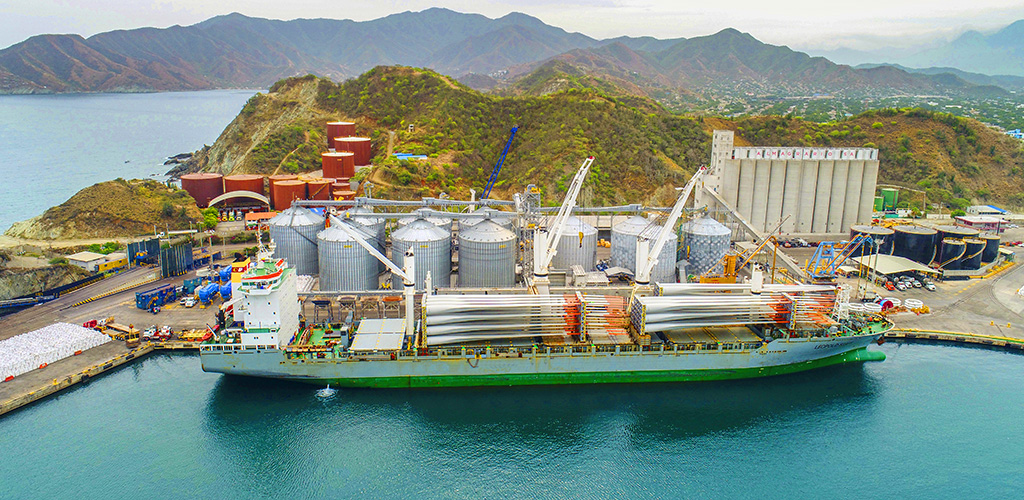Sep 06 | 2019
The view from David Buchanan, Deputy Editor, Latin Trade Magazine, who will moderate the LATAM project panel at Breakbulk Americas.

With such a vast region, there are so many interesting projects in Latin America right now and across most sectors, including airports, railways, seaports, energy and others. Here I'll talk us on a tour of some of the biggest and most ambitious ones.
BRAZIL
Starting with Brazil, there are a couple of projects to keep an eye on. Let’s begin with rail. The Minister of Infrastructure, Tarcísio Freitas, said in August that the government intends to nearly double the percentage of cargo carried by rail over the next eight years. Toward that aim is the Norte-Sul Railway, a very, very big railway which aims to link ports in the north and south ends of the country.
A similar project is the Ferrograo Railway that will take about 10 years to build. It will connect Brazil's central western region, the main grain producing area, to the inland port of Miritituba on the Tapajos River. Barges will then carry grains from Miritituba via the Amazon River out to world markets. These two projects would boost the country's ability to export its huge amount of grains and other goods it produces.
A third significant project is the revival of Eletrobras Eletronuclear’s third nuclear unit, Angra 3. Construction has been suspended since 2015, just one of many delays over four decades. Earlier this year, Energy Minister Bento Albuquerque said he hoped to restart the project for around $4 billion and begin generating power by 2026. While Angra 1 and Angra 2 account for only for about 3 percent of the country's electricity, I think it's a very good step forward toward increasing nuclear energy in Brazil.
MEXICO
In Mexico, I’m watching the Dos Bocas refinery, an $8 billion project owned by Pemex. The refinery would produce 340,000 barrels per day of heavy crude. Preliminary construction began in May with dredging of the adjacent river. I believe the cost will likely run up to between $10 billion and $12 billion and not likely to be completed until 2023 or even 2025. [Ed. Note: Pemex unsuccessfully tried to award a project management contract for Dos Bocas in May, but none of the interested parties— Bechtel, Grupo Techint, Jacobs and KBR—could match the government's demands that the refinery be built in less than three years and for less than $8 billion, according to a report from S&P Global Platts.]
Another project is a new airport for Mexico City, which has already become quite controversial. President Andrés Manuel López Obrador announced last spring plans to build a new airport for Mexico City to replace the nearly half-built $13 billion project he cancelled upon taking office. The new $4.1 billion Felipe Ángeles airport will be located at the Santa Lucia military air base and is scheduled to open in mid-2021.
Obrador has recently talked about reviving plans for the Isthmus of Tehuantepec Corridor, a 77-mile long
“dry canal” rail project that would connect the Gulf of Mexico with the Pacific Coast at Mexico’s narrowest point. It could provide an alternative route to the Panama Canal, especially for LNG ships going to Japan.
GUATEMALA
Moving south, keep an eye on Guatemala’s Interoceanic Corridor. Although it's not clear at the moment what the status is, this is an ambitious $10 billion project to connect the Pacific and the Atlantic oceans via road and rail, as well as oil and gas pipelines along a free trade zone, anchored by two deep water ports at each end.
COLOMBIA
Colombia is looking at one of the most innovative projects in the region. The $2.4 billion Ferropista project includes an all-electric 55-km rail line and a 44.2km tunnel through the Cordillera Central mountains, connecting Armenia and Ibagué. The project is designed to carry loaded trucks on the railway to not only relieve congestion and shorten transit time, but increase trade by 39 percent in the Port of Buenaventura by 2027.
PERU
Peru is underway with its $3 billion Chancay megaport project, located north of Lima, since COSCO Shipping and Peruvian mining company Volcan signed the deal last May. Chancay would provide a hub for cargo ships sailing between Asia and Latin America's West Coast. Construction should start in April 2020 and take around 28 months.
REGIONAL PROJECTS
SeaOne Caribbean’s $20 billion Caribbean and Central American Fuels Supply Project is one of the biggest
in the region. It would allow for the transportation of natural gas and natural gas liquids as a single cargo from North America all the way to South America. SeaOne plans to build a Compressed Gas Liquid production and export terminal in Gulfport, Miss., along with CGL receiving terminals in the Dominican Republic and Colombia, as well as at least two specialized ships under a contract with Sembcorp.
Finally, we turn to the $15+ billion Bi-oceanic Railway—an ambitious project that aims to connect the whole of South America's Atlantic and Pacific coasts. Imagine 4,000 kilometers of rail passing from the Port of Santos, Brazil all the way to the Port of Ilo in Peru, through Bolivia and Paraguay. It would save about 20 days for Brazilian and Bolivian exports to Asia. Again, this project underlines the growing importance of Asia as both an export and import partner to Latin American countries.
RELATED SESSION AT BREAKBULK AMERICAS
Identifying Project Potential in LATAM Markets
Wednesday, October 9
1:30 - 2:30
Breakbulk Main Stage
Moderator:
David Buchanan, Deputy Editor, Latin Trade Magazine
Panelists:
Leandro Brusque, Supply Chain Manager, Subsea Construction, Ocyan Oil & Gas
Tony Duncan, Executive Vice President, Magma Global
Spencer Nicolary, Sr. Director Supply Chain, Newmont Mining Corporation
Luis Martínez Leon, Chief Commitment Officer & President, BLK Global Logistics






